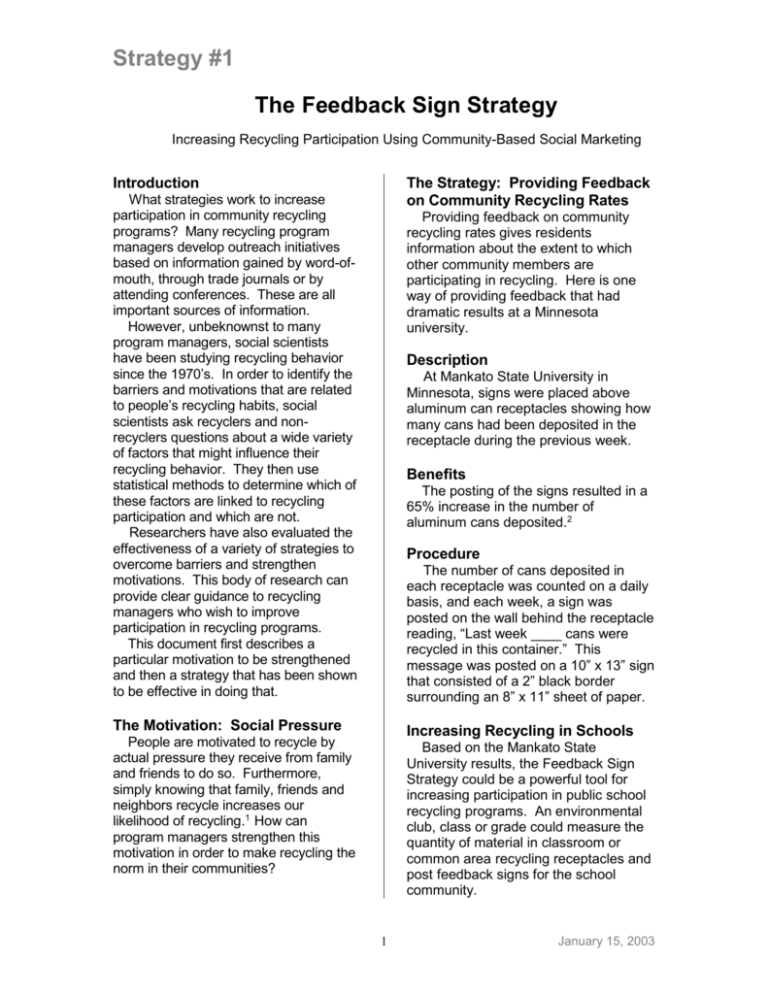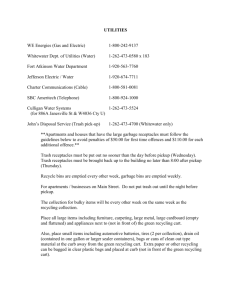The Drop-off Center Feedback Sign Strategy
advertisement

Strategy #1 The Feedback Sign Strategy Increasing Recycling Participation Using Community-Based Social Marketing Introduction The Strategy: Providing Feedback on Community Recycling Rates What strategies work to increase participation in community recycling programs? Many recycling program managers develop outreach initiatives based on information gained by word-ofmouth, through trade journals or by attending conferences. These are all important sources of information. However, unbeknownst to many program managers, social scientists have been studying recycling behavior since the 1970’s. In order to identify the barriers and motivations that are related to people’s recycling habits, social scientists ask recyclers and nonrecyclers questions about a wide variety of factors that might influence their recycling behavior. They then use statistical methods to determine which of these factors are linked to recycling participation and which are not. Researchers have also evaluated the effectiveness of a variety of strategies to overcome barriers and strengthen motivations. This body of research can provide clear guidance to recycling managers who wish to improve participation in recycling programs. This document first describes a particular motivation to be strengthened and then a strategy that has been shown to be effective in doing that. Providing feedback on community recycling rates gives residents information about the extent to which other community members are participating in recycling. Here is one way of providing feedback that had dramatic results at a Minnesota university. Description At Mankato State University in Minnesota, signs were placed above aluminum can receptacles showing how many cans had been deposited in the receptacle during the previous week. Benefits The posting of the signs resulted in a 65% increase in the number of aluminum cans deposited.2 Procedure The number of cans deposited in each receptacle was counted on a daily basis, and each week, a sign was posted on the wall behind the receptacle reading, “Last week ____ cans were recycled in this container.” This message was posted on a 10” x 13” sign that consisted of a 2” black border surrounding an 8” x 11” sheet of paper. The Motivation: Social Pressure Increasing Recycling in Schools People are motivated to recycle by actual pressure they receive from family and friends to do so. Furthermore, simply knowing that family, friends and neighbors recycle increases our likelihood of recycling.1 How can program managers strengthen this motivation in order to make recycling the norm in their communities? Based on the Mankato State University results, the Feedback Sign Strategy could be a powerful tool for increasing participation in public school recycling programs. An environmental club, class or grade could measure the quantity of material in classroom or common area recycling receptacles and post feedback signs for the school community. 1 January 15, 2003 Strategy #1 longer time period to determine if the signs have a lasting effect. 6. Another option is to measure the quantities in the receptacles every other week while the signs are up. This allows you to test the effectiveness of the feedback over a six week period without increasing the amount of work. In this case, the signs would indicate the particular week to which the quantity pertained, and each sign would remain up for two weeks. 7. At some point, the signs could be removed to determine if changes in recycling behavior are maintained without the feedback. Resources Needed The materials required could be as simple as attractively produced paper signs neatly attached to the wall above the receptacles. The time required would depend on the number of receptacles for which feedback was to be provided and the method of measuring the amount of material deposited in them. Weighing the material in a receptacle takes significantly less time than counting every item. The weight can then be converted to number of items or volume (“Enough bottles and cans were recycled in this container last week to fill 16 book bags….”) Evaluation Method Additional Research Needed It would also be beneficial to test this 1. Measure the average weekly amount of material recycled in each receptacle over a period of three weeks before putting up any feedback signs. 2. Put feedback signs up for three weeks in a row over some of the receptacles, but not all of them. If you put signs over some receptacles that get a lot of use, leave some heavily used receptacles without signs. Similarly, if you put signs over some lightly used receptacles, leave some other lightly used receptacles alone. 3. Measure the average weekly amount of material recycled in each receptacle (whether it has a feedback sign or not) during the three weeks while the signs are up. 4. Compare the difference in quantity in the signed receptacles before and during the feedback to any change in the amount in the unsigned receptacles during the same time period. If the change in quantity in the signed receptacles is greater than the change in the unsigned receptacles, then the signs are making a difference. 5. If the signs are making a difference, continue providing feedback over a strategy in a community drop-off center setting, because it would require a minimum of time and expense. The time would involve doing weight to volume conversions and replacing or modifying feedback signs on a regular basis. The expense would be in sign material and possibly hardware to mount the signs near the appropriate roll-off container. It would be important to test whether providing new feedback on a monthly or bimonthly basis (the frequency with which roll-off containers are often emptied and weighed) would be as effective as weekly feedback. Since the study conducted in Minnesota lasted for only four weeks, it would also be important to determine whether feedback provided over a longer period of time would result in a lasting increase in recycling tonnage. Evaluation Method for Drop-off Test 1. Compare the tonnage for 3 - 4 months before the signs are installed to the tonnage collected during the test period (also 3 - 4 months). 2 January 15, 2003 Strategy #1 This project is funded by a grant from the Massachusetts Department of Environmental Protection. 2. Compare the tonnage collected during the same months the previous year. If the percentage change this year is greater than last year, then the signs are making a difference. 3. If the signs are making a difference, the community could continue providing feedback over a longer time period to determine if the signs have a lasting effect. At some point, the community could also remove the signs to determine if changes in recycling behavior are maintained without the feedback. This document was prepared by Aceti Associates of Arlington, MA. Printed on recycled paper Questions? Contact Brooke Nash of the Massachusetts Department of Environmental Protection at 617-2925984. End Notes 1Gamba, R. & Oskamp, S. (1994); Oskamp, S. et. al. (1991); Werner, C. M. & Makela, E. (1998) 2Larson, M.E., et. al (1995) References Gamba, R. & Oskamp, S. (1994). Factors Influencing Community Residents’ Participation in Commingled Curbside Recycling Program. Environment and Behavior, 26 (5) 587-612. Larson, M.E., Houlihan, D. & Goernert, P.N. (1995). Brief Report: Effects of Informational Feedback on Aluminum Can Recycling. Behavioral Interventions, 10(2) 111-117. Oskamp, S., Harrington, M., Edwards, T., Sherwood, D., Okuda, S. & Swanson, D. (1991). Factors Influencing Household Recycling Behavior. Environment and Behavior, 23 (4) 494-519. Werner, C.M., & Makela, E. (1998). Motivations and Behaviors That Support Recycling. Journal of Environmental Psychology, 18, 373-386. 3 January 15, 2003







![School [recycling, compost, or waste reduction] case study](http://s3.studylib.net/store/data/005898792_1-08f8f34cac7a57869e865e0c3646f10a-300x300.png)